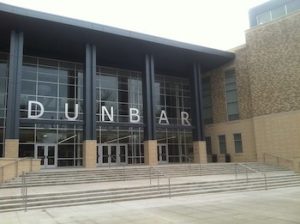
*On this date in 1870, we affirm the opening of (Paul Laurence) Dunbar High School. Dunbar High School is a public secondary school in Washington, D.C., United States.
Originally named the Preparatory High School for Colored Youth from 1891 to 1916, it became M Street High School. The school was founded as an educational mission at the Fifteenth Street Presbyterian Church. The school was one of America's first public high schools for Black students. When its location was changed from M Street, the school was renamed in 1916 for the African American poet Paul Laurence Dunbar, who died in 1906.
As more high schools had been established, Dunbar was designated as the city's academic high school, with other schools providing more vocational or technical training. Dunbar was known for its excellent academics, so some black families moved to Washington specifically so their children could attend it. All the public school teachers were federal employees, and Dunbar's faculty was paid well by the standards of the time, earning parity pay with Washington's white schoolteachers. The school boasted many graduates who pursued higher education and a generally successful student body. The school is located in the Truxton Circle neighborhood of Northwest Washington, two blocks from the intersection of New Jersey and New York avenues.

Dunbar serves grades 9 through 12 and is a part of the District of Columbia Public Schools. From the early 20th century to the 1950s, Dunbar became known as the classical academic high school for black students in segregated public schools. As all public school teachers were federal civil servants, their teachers received pay equal to that of white teachers in other schools in the district. It attracted high-quality faculty, many with advanced degrees, including doctorates. Parents sent their children to high school nationwide because of its high standards. Many of its alumni graduated from top-quality colleges and universities and gained professional degrees.
Since its inception, the school has graduated many well-known figures of the 20th century, including Sterling Brown, H. Naylor Fitzhugh, Nannie Helen Burroughs, Charles R. Drew, William H. Hastie, Charles Hamilton Houston, Robert Heberton Terrell, Benjamin O. Davis, Jr., Paul Capel, III, Robert C. Weaver, and James E. Bowman and others. Its faculty included Anna Julia Cooper, Kelly Miller, Mary Church Terrell, A.A. Birch Jr., Carter G. Woodson, and Julia Evangeline Brooks, a school graduate. Anna Cooper, Richard Greener, Mary Jane Patterson, and Robert Heberton Terrell were principals. Many teachers and principals held Ph.D. degrees.
Until the 1954 Supreme Court Case Brown v. Board of Education ruled for integrating public schools, Fairfax County, Virginia, had no secondary schools for Black students. Dunbar and several other District of Columbia public schools could accept Black students from the county before that time. In the 21st century, Dunbar is similar to its namesakes in Baltimore, Maryland, Fort Worth, Texas, and others; the majority Black student body with the local African American community. All three schools are also highly regarded for their athletic programs within their respective school district in football, basketball, and track sports. There is also a Paul Laurence Dunbar High School in Lexington, Kentucky.